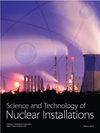Investigation of Oxidation and Counter-Oxidation in a One-Quarter Circular Geometry due to Shadow Corrosion
IF 0.9
4区 工程技术
Q3 NUCLEAR SCIENCE & TECHNOLOGY
引用次数: 0
Abstract
To optimize fission fuel and protect cladding integrity, this work investigates shadow corrosion in a one-fourth circular electrode geometry. The anodic corrosion of Zircaloy-2 (Zry-2) was investigated in a circular geometry electrode configuration under reactor operating conditions. The impact of gamma and neutron radiations on water conductivity and shadow corrosion was examined under two different cathodes. This work also investigates the effect of current exchange density and the cathodic Tafel coefficient on the cathodic current. Using COMSOL Multiphysics 5.2, the Laplace equation was solved to obtain the electrostatic potential and current density distributions in the studied domain. When the distance d between the anode (Zry-2) and cathode (platinum/nickel) is ≤0.5 mm, it was observed that a uniform oxide layer of thickness 20 µm grew on the smooth internal surface of Zry-2 for corrosion lasting 1166 h. When d > 0.5 mm, the oxide thickness falls in a manner dictated by the degree of dissociation α of the electrolyte. At a cladding gap of 0.08 mm, a radiation-enhanced uniform corrosion rate of 2.405 10−1 mmpy was obtained for Zry-2. This value is 142 times greater than that obtained at room temperature in the absence of radiation. It was also observed that the corrosion rate falls at higher cladding gaps, and the rate of change depends on the degree of dissociation. Other phenomena such as the dynamics of shadow corrosion under varying electrode separation and electrolyte conductivities, as well as extensive evaluation of critical fuel cladding parameters, are presented in this work.四分之一圆形几何体因阴影腐蚀的氧化和反氧化研究
为了优化裂变燃料并保护包壳的完整性,本工作研究了四分之一圆形电极几何形状中的阴影腐蚀。研究了锆合金-2(Zry-2)在圆形电极结构下在反应器操作条件下的阳极腐蚀。在两种不同的阴极下,研究了伽马和中子辐射对水电导率和阴影腐蚀的影响。本文还研究了电流交换密度和阴极塔菲尔系数对阴极电流的影响。使用COMSOL Multiphysics 5.2,求解拉普拉斯方程,以获得所研究区域中的静电势和电流密度分布。当阳极(Zry-2)和阴极(铂/镍)之间的距离d≤0.5时 mm,观察到厚度为20 µm生长在Zry-2光滑的内表面上,腐蚀持续1166 h.当d > 0.5 mm,氧化物厚度以电解质的离解度α决定的方式下降。在0.08的包层间隙 mm时,Zry-2的辐射增强均匀腐蚀速率为2.405 10−1 mmpy。该值是在没有辐射的情况下在室温下获得的值的142倍。还观察到,腐蚀速率在较高的包层间隙处下降,变化速率取决于离解程度。本文还介绍了其他现象,如在不同电极间距和电解质电导率下的影子腐蚀动力学,以及对关键燃料包壳参数的广泛评估。
本文章由计算机程序翻译,如有差异,请以英文原文为准。
求助全文
约1分钟内获得全文
求助全文
来源期刊

Science and Technology of Nuclear Installations
NUCLEAR SCIENCE & TECHNOLOGY-
CiteScore
2.30
自引率
9.10%
发文量
51
审稿时长
4-8 weeks
期刊介绍:
Science and Technology of Nuclear Installations is an international scientific journal that aims to make available knowledge on issues related to the nuclear industry and to promote development in the area of nuclear sciences and technologies. The endeavor associated with the establishment and the growth of the journal is expected to lend support to the renaissance of nuclear technology in the world and especially in those countries where nuclear programs have not yet been developed.
 求助内容:
求助内容: 应助结果提醒方式:
应助结果提醒方式:


